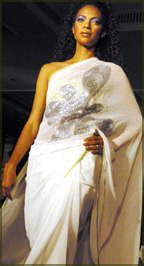|
DAILY NEWS ONLINE |
|
|
|
OTHER EDITIONS |
|
|
|
|
|
|
|
|
|
OTHER LINKS |
|
|
|
|
|
|
 |
|
Indian sari falls from grace as urban women adopt Western stylesBANGALORE, India, (AFP) - Spoiled for choice with easy-to-wear western-style clothing, Indian urban women are discarding the traditional Indian sari en masse. Top fashion gurus say the sari, a long strip of cloth with one end wrapped around the waist to form a skirt and the other draped over the shoulder or covering the head, is fast being cast aside in favour of skirts, dresses, tops, jeans and trousers (pants).
Long the bedrock of Indian attire, the sari was seen as a dress for all seasons - be it in the home or at the office, weddings or parties. The only differentiation was in the texture, fabric and the heavy embroidery. But with Indian markets opening up, typical western clothing and Indian alternatives such as the salwar kameez (a long shirt worn with loose pants) and kurti (a short tunic) have flooded fashion stores. "(Women) are experimenting due to the ease and practicality of other clothes, mainly western," said Wendell Rodricks, an Indian fashion designer who has been selling his own label since 1990. "Women find it impractical as it takes a long time to drape a sari. These days they look at ease of wearing. I feel it will be difficult for the sari to (be sustained) as an everyday garment," Rodricks told AFP. "Soon it will be replaced by other garments that are easier to wear. It may be either western or Indian." The sari, however, is not under threat of extinction. "It will become a special occasion wear, evening or wedding wear and it will stay in that category," he said, adding that aside from comfort, the wearing of western clothes was seen as a status symbol. The saris most favoured by Indian women originate from three regions - Varanasi in northern Uttar Pradesh state, Chanderi in central Madhya Pradesh and Kancheevaram in southern Tamil Nadu. Aparna Chandra, a fashion stylist who owns her own label, said alternative Indian clothes such as the salwar kameez and kurti, as well as western shirts and jeans, had replaced the sari. "The main reason is comfort and option," she said. "There are many people looking around for different options when it comes to clothes. The sari being discarded has a lot to do with the comfort factor. "There are also options one can choose from now. There were not many earlier. Jeans and tops are the best examples," said Chandra, herself sporting a white top and a pink flower print skirt. Just draping the five yard (4.5 metre) sari may take a woman anything from 15 minutes to half an hour. And then there's the problem of getting the pleats just right - traditions vary according to the region. Pleats are worn at the back in some states and in the front in others. Designer Chandra said she would not wear a sari on a normal day as she preferred to look casual. "The reason I will not wear a sari is that I feel very dressed up in it. I keep it for special occasions," she said. A sari designed by Chandra and other fashion stylists in India will cost between 110 dollars and a whopping 4,500 dollars. Soon after India announced its economic liberalisation policies a decade ago, foreign brands such as Morgan De Toi, Nine West, Mango and Valentino moved in to its shopping malls. Malini Ramani, an Indian designer who graduated from the New York-based Fashion Institute of Technology and whose label is popular with Bollywood stars, echoed Chandra's views. She said the "modern" Indian woman wanted clothes that suited her lifestyle. "Life has become so much faster. To look after a sari and drape it takes a lot of time," Ramani told AFP. "Most of the time a woman do not want to feel elegant. They need clothes that they can wear to work. "The market for a designer sari is not hot. I sell a limited (number of) saris but with a lot more funky stuff which glitters," Ramani said. The designers agreed they could not innovate the Indian sari too much at the cost of making it look like a "gown". "I would imagine the designer sari market will be about only seven to ten percent of the total designer market," said designer Rodricks. "Not many women are adventurous to wear a new kind of sari. They want it traditional," he said. "There is a small public that is willing to experiment. If we designers try and give some modern twist to the sari it will be accepted more." The Indian clothing industry is estimated at 16 billion dollars annually while the nascent fashion design industry is worth about 60 million dollars. |
|
|
|
 |
 |
 |
 |


